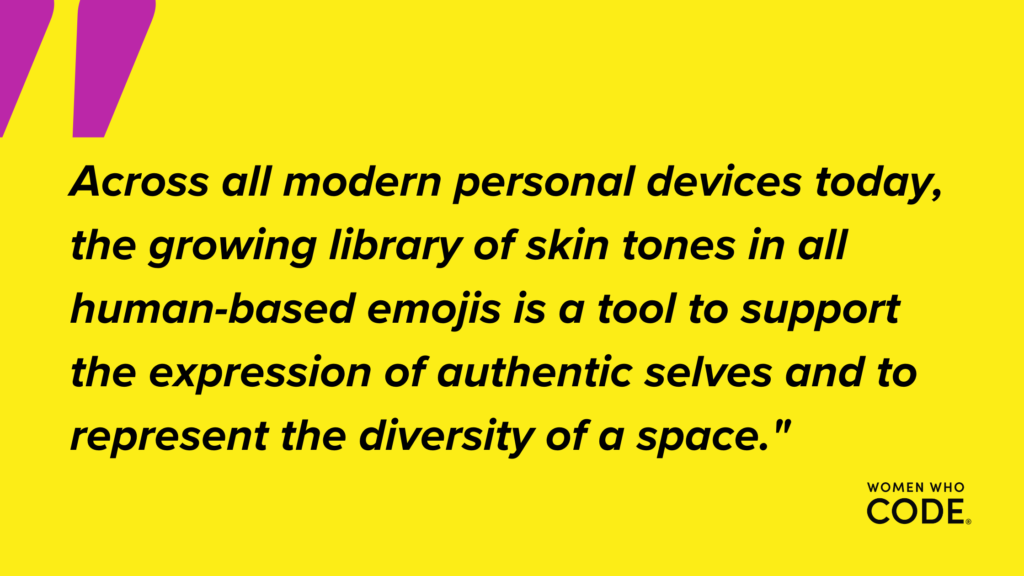The Power of Emojis in Subverting Racial Assumptions in Digital Spaces
Written by Manda Frederick

You’re thinking, “🤔 What a serious title for a blog about emojis to celebrate World Emoji Day.”
I know, right? But stick with me a minute, and I’ll show you what I mean. 🙏
In Critical Race Theory, “default whiteness” is a term used to explain, that, in digital space, left without any markers of race — someone’s online username is simply “User1234”, for example — most people will assume that the user on the other side of the screen is white.
✅ You can test this out yourself. Show a friend or colleague some code or writing from an online source and ask them if they can guess the race of the dev or writer. It doesn’t matter if you know anything about the demographics of the source for this exercise; default whiteness says your friend or colleague will probably guess the source is white.
Default whiteness is problematic because it is a form of whitewashing — it implicitly and discriminately replaces the diverse participants in digital spaces with white ones. Whitewashing any space eliminates representation, creates psychologically unsafe environments for diverse participants, threatens the well-being of unseen members, and creates an inaccurate depiction of who is contributing to that space. 😞
Our growing technical world is increasingly diverse; in fact, that’s the very mission of Women Who Code. But if we increase representation in tech but the fundamental assumption is that the work being seen in digital space is being done by white participants only, that isn’t ideal. As more work and community are housed in digital spaces, we have a duty not only to support diversity, equity, and inclusion but to bring visibility to representation in these spaces.
But how can we better subvert racial assumptions — and undermine default whiteness – in digital space?
To start, we must normalize expressions of race in digital spaces. This must specifically be done in professional and academic settings. According to Kevin Eric DePew in the Handbook of Research on Computer Mediated Communication, expressions of race in more formal settings have traditionally been seen as “taboo.”
Normalization of racial expression goes hand-in-hand with leveraging the tools now available to us in the spaces where we learn and work. The tools we can use in digital space to amplify diversity have come a long way from the lonely blinking green cursor of early Apple computers.

We can adorn our digital profiles with headshots or avatars that represent us, display our chosen pronouns, and provide the textual or auditory pronunciation of our names. We are also blessed with an abundance of emojis to support the communication that we do.
While emojis, developed by Japanese companies in the late 1990s and debuting in mobile phones via Apple in 2008, may be seen as a way to simply add a little flair to language or even to replace the need for language altogether, they are so much more than that. Emojis have been on a trajectory of diversity since 2013, when Katrina Parrott proposed to Unicode that the all-white emojis should be diversified, and then with Apple diversifying its emoji library for iPhones in February 2015.
Across all modern personal devices today, the growing library of skin tones in all human-based emojis is a tool to support the expression of authentic selves and to represent the diversity of a space.
To support DEI in your digital working and learning environments, 💡consider leveraging the tools of those spaces to make the diverse representation of your team more visible by:
- 🗣️ Fostering an open dialogue with your colleagues, peers, or manager about identity expression via emojis (or other tools like avatars or pronoun designation) to ensure such expressions are safe and welcomed.
- 📖 Educating your team about the emoji library and how it can represent gender, race, ability, location, and more.
- 💻 Encouraging the use of emojis with your teams on Zoom calls and in your chat platforms, like Slack or Discord.
Emojis are a lot of fun. They bring an element of play, surprise, beauty, poetry, and expression to text in a way that wasn’t possible before. But, as they have co-evolved in our diverse world, they can also do important work to support more equity and inclusion — and that merits applause with whatever hands feel right to you. 👏👏🏻👏🏼👏🏽👏🏾👏🏿